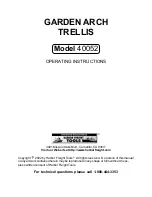
HONEYWELL EMERGENCY NOTIFICATION MANAGER
39-00008-1
30
• Special Function Zone ZF20 (MN alarm) must not be
mapped to Fire outputs, as outputs mapped to ZF20 will
not be suppressed.
WARNING
DO NOT USE ZF20 TO TURN ON MASS
NOTIFICATION DEDICATED OUTPUTS WHEN FIRE
IS THE HIGHEST PRIORITY.
Outputs:
• All outputs used for MN must be programmed as non-
silenceable. This includes those outputs that are shared
between MN and other events, such as Fire.
• Dedicated Fire outputs can be programmed as silenceable
or non-silenceable.
• Outputs mapped to Special Function Zone ZF20 will not be
suppressed. See Warning above.
Audio:
• MN sequences playing on an XLS-DVC will be silenced,
and the XLS-DVC will sound the Fire Active Tone while MN
is suppressed.
• MN sequences on an XLS-DVC will not sound, and the
XLS-DVC will sound the Fire Active Tone while MN is
suppressed.
Mass Notification Control Operation
For all panels and network annunciators except EBI
Workstation, the "Controls Active" LED indicates if control
functions are enabled. If the controls active LED is off, or the
EBI Workstation control lockout icon is present, Acknowledge,
Signal Silence, System Reset or Drill can not be performed.
When the control functions are blocked, the XLS-NCA2,
XLS3000 and LCD-160 display "Local Control Disabled" when
an Acknowledge, Signal Silence, System Reset or Drill is
attempted.
Control will be given to an XLS3000 (in network display
mode), XLS-NCA2, LCD-160, or EBI Workstation only during
an MN page from that control unit. When no MN page is in
progress, local control is active at each panel that does not
have it disabled.
On panels that are not part of an ACU, LOC or CCS, local
control will be removed when a local MN alarm is active. A
local MN alarm is one that has initiated at the local panel, or
one that has activated on a remote node that is MN mapped to
the local panel. An LCD-160 will follow the XLS3000 it is wired
to, removing control when the panel does.
An MN page at an XLS-DVC will:
• Give control to its assigned XLS-NCA2 or XLS3000, which
will maintain its Controls Active LED on and maintain
control functions as unblocked
• Turn off Control Active LEDs and block control functions at
all other panels and annunciators.
An MN page at a DVC-RPU will:
• Give control to its assigned LCD-160, which will maintain
its Controls Active LED on and maintain control functions
as unblocked.
• Turn off Control Active LEDs and block control functions at
all other panels and annunciators.
An MN alarm that is not activated by an MN page:
• XLS-NCA2's and XLS3000's (in network display mode) will
remain in control: their Controls Active LEDs will remain on
and their control functions will remain unblocked.
• XLS3000s not in network display mode and XLS140-2's,
and XLS120’s will extinguish their Controls Active LEDs
and their control functions will be blocked.
Paging
When a system has MN capabilities, the second column on an
XLS-DVC or DVC-RPU keypad has three functional buttons
representing three priority levels of paging. If MN is the
highest priority in the system, pressing the highest button will
create an MN page locally and to all MN mapped nodes,
initiating an MN alarm and suppressing fire activations. If Fire
is the highest priority, pressing the highest button in column
two will create a Fire page to all mapped nodes. Pressing the
Level 3 (GENERAL PAGE) button will create a general ALL
CALL page that will not suppress any fire activations.
Buttons in the two right columns of the keypad can also create
an MN alarm if programmed to do so. ACU's take priority over
LOC's, and LOC's take priority over CCS's.
Fig. 36. DVC-KD Keypad
Drill Operation
Drill operation is blocked while fire activations are suppressed.
So if MN is the highest priority in the system, an MN Alarm on
the local panel or on a network panel that is MN Mapped, drill
operation, including custom drill operation, will be blocked.
This is to prevent the user from activating fire outputs while a
mass notification is in progress.


































